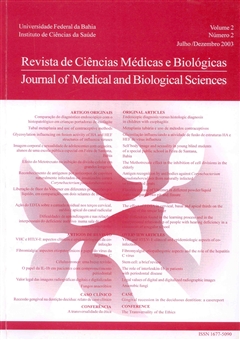VHC and HTLV- I: clinical and epidemiologic aspects of co-infection
DOI:
https://doi.org/10.9771/cmbio.v2i2.4290Keywords:
Hepatitis C (HCV), HTLV, Co-infection.Abstract
The hepatitis C virus (HCV), which infects 3% of the world population, about 170 million people, and the HTLV-I virus (human T-cell lymphotropic virus I), responsible for endemic infections in various regions of the world, are highly prevalent in the Northeast of Brazil. The co-infection by both viruses, HLTV and HCV, has not been well understood as far as clinical and epidemiologic aspects are concerned. Physicians from this region urge to understand it better because of the wide epidemiological impact of those viruses in Bahia State. There is great knowledge about each virus individually, however the infection consequences have been poorly examined up to the moment. Because of their characteristics, which infect the immune system cells, and the fact that they result in different modulations of the host immune response, a natural alteration of the evolution process is expected when both viruses are present. Through a systematic review of scientific papers, meaningful data concerning the co-infection HCV/HTLV-I as well as the information about its effects on the host were collected for this analysis. Due to the few numbers of published papers or books related to that subject, this researcher has come to the conclusion that there is still a great gap to be fulfilled in this area. Thus, this paper aims at providing the physicians with some useful bibliographic review about the recent progress concerning this co-infection in order to contribute towards the understanding of its impact on patients’ lives.Downloads
Download data is not yet available.
Downloads
Published
2003-01-01
How to Cite
Rêgo, A., Feitosa, F., Cavalcante, D., & Paraná, R. (2003). VHC and HTLV- I: clinical and epidemiologic aspects of co-infection. Journal of Medical and Biological Sciences, 2(2), 230–239. https://doi.org/10.9771/cmbio.v2i2.4290
Issue
Section
Review Articles
License
The Journal of Medical and Biological Sciences reserves all copyrights of published works, including translations, allowing, however, their subsequent reproduction as transcription, with proper citation of source, through the Creative Commons license. The periodical has free and free access.


